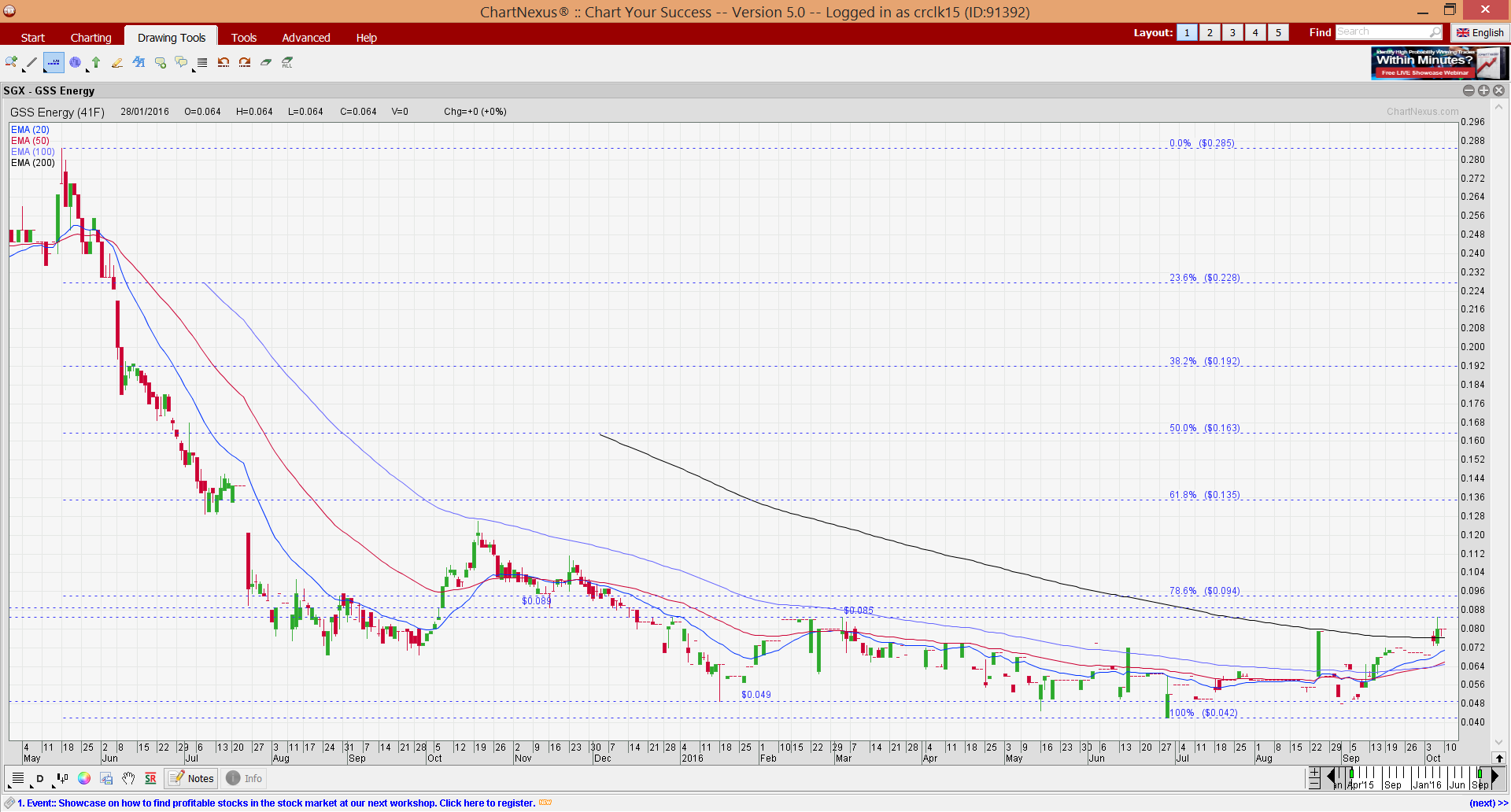 Sydney Yeung, CEO of GSS Energy. Sydney Yeung, CEO of GSS Energy. NextInsight file photo.GSS Energy’s (“GSS”) recent share spike and chart action caught my attention. GSS has surged 67% from $0.048 on 1 Sep 2016 to close at $0.080 on 10 Oct 2016. It has just moved above its 200D exponential moving average (“EMA”) for the first time in 16 months! Furthermore, GSS announced that its subsidiary was awarded a KSO contract from Pertamina for oil production in the Trembul Operation Area. In view of the chart and company’s developments, I met up with Mr Sydney Yeung, CEO of GSS Energy, for an exclusive discussion of the company’s business developments and prospects. |
Below are the key takeaways from the meetup.
1. KSO contract differs significantly from their previous old well contracts
Some important differences are as follows:
a) Low probability of the contract being cancelled
Previously, the old well contract which GSS had, was suddenly terminated on 16 Jul 2015. This was because Pertamina terminated the contract with the local cooperative, KUD. As a result, KUD does not require the GSS’ services (i.e. GSS is akin to a subcontractor in this contract). Since then, GSS learnt from their previous experience and made a few significant changes in this latest contract.
Firstly, Pertamina awarded the KSO contract directly to GSS’ subsidiary PT Sarana GSS Trembul (“PT SGT”). Secondly, PT SGT is a joint venture between GSS Energy and PT Sarana Pembangunan Jawa Tengah (“PT SPJT”), a commercial vehicle wholly-owned by the Provincial Government of Central Java which holds stakes in various large-scale infrastructure projects in Indonesia. Thus, this joint venture is quasi state-owned to a certain extent. With the backing of Provincial Government, it is less likely for the contract to be cancelled.
b) Funds will be paid directly to GSS
Under the old well program, GSS produced oil and delivered it to KUD. KUD then sold it to Pertamina and Pertamina paid to KUD. Only after that would KUD pay GSS. Thus, there were multiple layers involved and collection was slower and less certain. However, with this KSO contract, GSS PT SGT will sell to Pertamina and Pertamina pays PT SGT directly.
c) Cost recovery model
In a simplistic manner, KSO contract works on a cost recovery model. This means that the sale proceeds which GSS gets from the sale of oil will be used to offset against the capital expenditure required in drilling oil. Any excess will be split in a pre-determined manner between Pertamina and GSS.
2. Low cost of oil production
According to management, its cost of oil production is in the low teens. The cost of production is low due in part to the following factors:
a) Onshore drilling, initially target up to 800m;
b) Rig operators are charging lower rates due to depressed oil prices and lack of business;
c) Trembul area has good logistic facilities which result in lower logistic costs incurred.
3. High probability of oil production
ExxonMobil has its largest onshore oil field production in the Trembul Operation Area. Notwithstanding the inherent risks of oilfield operation and production, management is optimistic that the Trembul Operation Area has oil because
a) ExxonMobil’s oil production is in close proximity to GSS
In terms of oil production, ExxonMobil produces about 180K barrels / day and it targets to increase to 240K barrels / day. As ExxonMobil’s site is in close proximity to GSS, it is likely that GSS site should be able to produce oil too.
b) Old well data corroborates management’s optimism
According to a Qualified Person’s Report (QPR), Trembul area has a net substantial 24.32 million stock tank barrels of high estimate Contingent Resources up to the depth of 800 metres. Potential reserves beyond 800 metres depth has not been estimated yet. This QPR corroborates management’s optimism that there is a high probability of oil production.
|
4. Value of Trembul oil fields
a) (10-15%) x the oil price which is around US$50 now: Whether it is 10% or 15% or a figure in between 10-15% of the oil price is subject to negotiation; |
5. Cash call to finance initial oil drilling – unlikely at this time
Based on 1HFY16 results, GSS is sitting on a net cash position of S$15m. Based on their existing estimates, it is unlikely that it has to do a cash call, unless they intend to expand their oil production aggressively. GSS expects to commence oil production by 1HFY17.
| ♦ Undervalued stock |
|
|
6. Robust engineering business – sustainable performance ahead
Precision Engineering (“PE”) business has been doing fairly well this year. Furthermore, GSS was awarded a significant order to produce game consoles for an established game console player which is expected to commence production late this year. Thus, it is likely that PE business should be fairly sustainable in the next couple of years. In addition, as GSS relocates into a new factory in Changzhou in 1HFY17F, it will do more active marketing for its PE business to utilise its expanded production capacity.
Chart analysis
Based on Chart 1 below, GSS has largely traded between the range of $0.050 – 0.085 since Dec 2015. Amid positive placed DIs, ADX is trending higher and closed at 27, indicative of a trend. 21D, 50D and 100D EMAs are moving higher with golden crosses formed between 21D and 50D; 21D and 100D and 50D and 100D. 200D EMA has stopped declining and GSS has closed above its 200D consecutively for the past three days, which is a feat, not seen in the past 16 months!
Based on my personal view, there seems to be a bullish tinge in the chart setup. It is likely that odds are higher of an eventual break above $0.085. A sustained break above $0.085 / below $0.050 with volume points to an eventual measured technical target of $0.120 / 0.015.
Near term supports: $0.075 / 0.071 – 0.073 / 0.064 – 0.065
Near term resistances: $0.085 / 0.089 / 0.094
Chart 3: GSS range trade between $0.050 – 0.085 since Dec 2015
Source: Chartnexus chart as of 10 Oct 2016
P.S: I have highlighted to my clients to take a look at GSS when it was trading around $0.05 – 0.06 approximately 2-3 months ago.
Conclusion
The recent KSO contract with Pertamina seems to be a game changer for GSS. Coupled with its thriving PE business and the bullish chart setup, this is an interesting company to take a closer look. However, readers should note the usual risks such as illiquidity; execution risk in the oil business division and the risks involved in doing business in Indonesia.
The above summarises the key takeaways from my meeting with Sydney, GSS Energy CEO. Readers should take a look at GSS Energy website HERE for more information.
Disclaimer
Please refer to the disclaimer HERE









And while Pertamina can terminate the contract with KUD, why can't the govt of central java renege on their commitment?